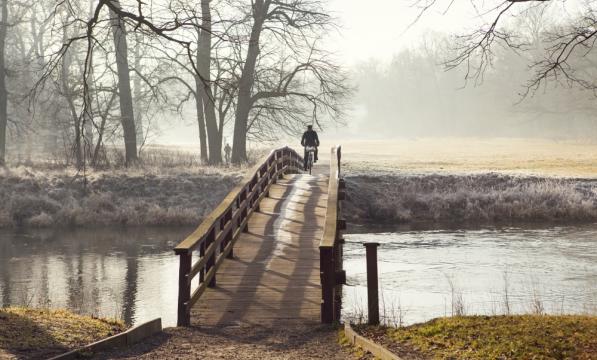Ice time for a ride: reading the signs

Cycling accidents on ice can often result in physical injury, so learning to read the weather signs and identify potential danger spots on your journey is essential. As a cyclist you know that certain stretches of your routes seem to be more treacherous than others, but why is this?
Met Office weather forecasts tell us when freezing temperatures are expected in our local area and many of us are inclined to keep an eye out for zero or minus temperatures as an indicator of when it could be icy. Nevertheless, it may come as a surprise that even when air temperatures are as high as four or five degrees Celsius, ground temperatures often dip below freezing so ice is possible.
At the start of winter, the ground still holds some warmth so frosts and ice are less likely, especially if there has been a warm autumn, but the likelihood of ice and frost increases as winter goes on. On days where winter sunshine warms the earth, the ground temperature increases, reducing the chance of frost.
However, exposed areas, low lying hollows or areas sheltered from the wind often have a lower ground temperature. It is these areas that are most susceptible to ice if there is surface moisture. These areas are also the last to thaw after ice and snow.
Even when air temperatures are as high as four or five degrees Celsius, ground temperatures often dip below freezing so that ice is possible
Roads, cycle tracks and pavement cycle paths all have different surfaces and respond differently to temperature. The smoother the surface, the less traction there is for a cyclist. Cycle paths can often follow canals or rivers, and in these locations moisture in the air may heighten the likelihood of ice.
Roads tend to warm up more quickly because passing cars displace cold air, while their tyres warm the road. Many roads are gritted but rural roads may not be and unfortunately local authorities are not obliged to grit cycle paths. Consider checking with your local council to find out which roads have been gritted and which have not and plan accordingly.
Suspension bridges designed for cycle use should always be approached carefully during periods of cold winter temperatures. The combination of moisture in the air and lack of warmth from the ground means that ice may appear here first. Exposed sections of roads and cycle paths may experience wind chill, which reduces surface temperature and increases the likelihood of ice forming if there is surface moisture.
Ice is simply water in a solid form, so anywhere that water gathers on surfaces and then freezes can cause potential problems for cyclists. The risk of this is obviously greater after rain when run-off has not had a chance to drain away or evaporate. Water gathers along the gutter and the sides of roads and this is often where current cycling infrastructure sits.
One of the main causes of black ice is when a big freeze follows a partial thaw; so that rain water or meltwater is frozen before it can drain off the road completely, leaving a thin layer of transparent ice. It is especially important to look out for puddles which cars have driven through, spreading the water more thinly so that it freezes as a thin, invisible film around the puddle.
The Met Office issues weather warnings for the whole of the UK. Yellow, Amber and Red warnings can help to advise pedestrians and road users about the possible presence of ice.
Unfortunately it is impossible to identify every area of ice in weather forecasts. Often ice forms in very localised places under localised conditions, so it is important for cyclists to be aware of the general forecast for the day ahead and to interpret it in the context of a particular cycle route.
The Met Office Weather app, available on Apple iOS and Android, can help make sure you have the most up-to-date weather information to hand.
The Met Office provides localised forecasts, updated every hour, for around 7,500 locations across the UK. With that knowledge, you can then judge the weather factors that could determine whether ice may form and consider adjusting your route, avoiding known hazards where ice is most likely.
If you end up cycling in icy conditions, make sure you check out our top tips.

